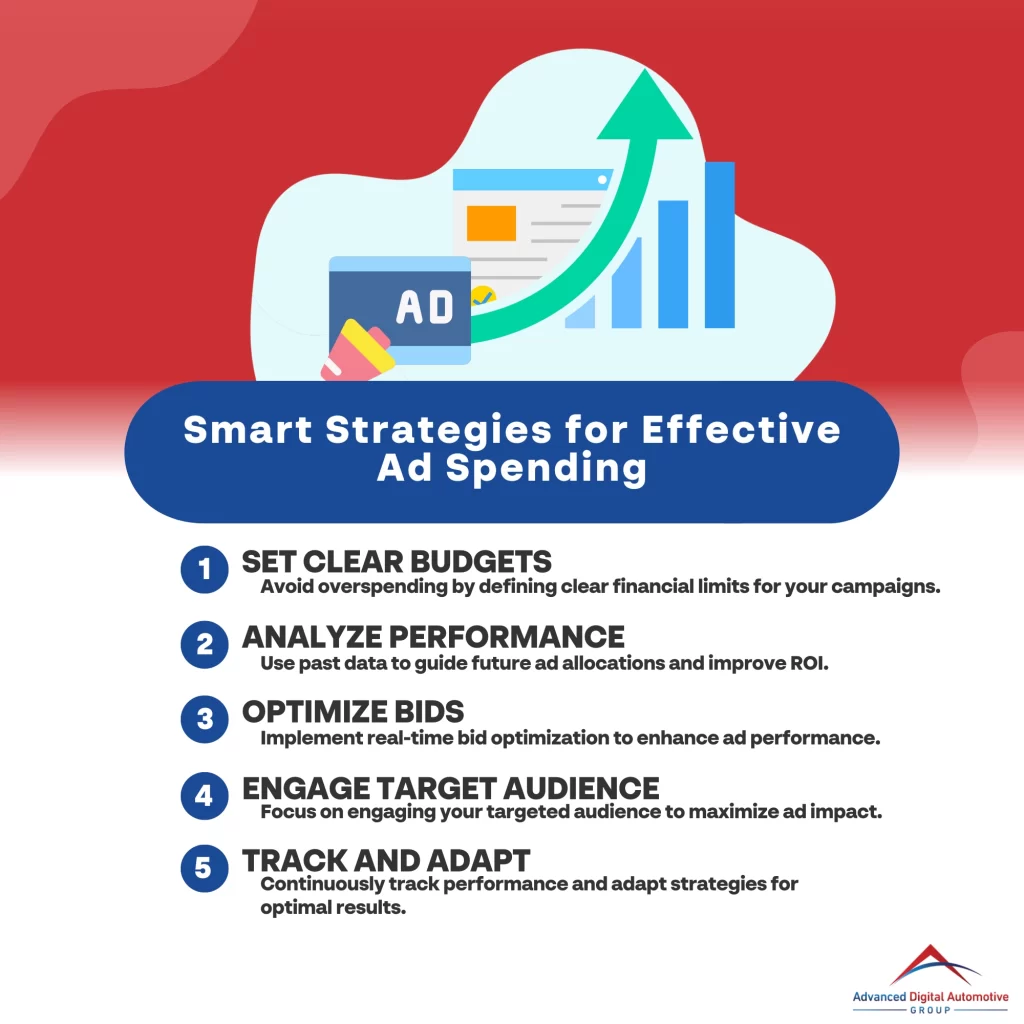Creating an affordable ads budget guarantees you maximize marketing impact without overspending. By analyzing past performance and predicting trends, you can strategically allocate funds to high-performing campaigns and minimize waste. This approach allows for flexibility through A/B testing and real-time bid optimization, increasing your return on investment. An affordable budget also empowers you to engage more effectively with your targeted audience. Regular performance tracking assures strategies remain effective and adaptive. With a clear financial plan, you can sustainably grow your advertising initiatives, leading to better outcomes. To uncover more about optimizing your ad spend, explore further.

Key Takeaways
- Prevents overspending and ensures strategic use of advertising funds.
- Maximizes advertising impact by analyzing past performance and predicting future trends.
- Allows for flexible testing of ad variations without financial strain.
- Ensures sustainable and impactful advertising initiatives for better outcomes.
- Optimizes ad spend by focusing on targeted audience engagement and performance tracking.
Benefits of Budgeting
Effective budgeting is an important strategy for maximizing the impact of your advertising efforts. When you understand how much to spend on Google Ads, you can allocate resources more efficiently and achieve better results. First, setting a clear budget helps you avoid overspending, making sure that every dollar is used strategically. You’ll have a clearer picture of your financial limits, allowing you to make informed decisions.
Knowing how much should I spend on Google Ads isn’t just about picking a number; it involves analyzing past performance and predicting future trends. By monitoring your Google ad spend, you can identify which campaigns are delivering the highest returns and allocate funds accordingly. This analytical approach helps you to fine-tune your strategies and focus on what works best.
Moreover, a well-planned budget allows you to test different ad variations without financial strain. You can experiment with various keywords, demographics, and bidding strategies to discover the most effective combinations. This level of flexibility is vital for adapting to market changes and staying competitive.
Ultimately, a thoughtful approach to budgeting guarantees that your advertising initiatives are both sustainable and impactful, driving better outcomes for your business.
Maximizing ROI
To maximize your ROI, you need to optimize your ad spend by focusing on targeted audience engagement and employing effective performance tracking strategies. By allocating your budget more strategically, you can guarantee that every dollar works harder for you. Tracking performance metrics will help you adjust and refine your efforts, leading to better outcomes and a higher return on your investment.
Optimize Ad Spend
Maximizing ROI in your ad campaigns is all about smart allocation of resources and constant optimization. To truly optimize ad spend, you need to start by determining how much to spend on Google Ads. This involves analyzing past performance data and setting clear objectives. Look at metrics such as cost-per-click (CPC), conversion rates, and customer lifetime value (CLV) to guide your budget decisions.
Google Ad spend should be viewed as an investment. Allocate more funds to high-performing keywords and campaigns, while cutting back on underperforming ones. Use A/B testing to compare different ad creatives and landing pages to see which combinations yield the best results. Consistently monitor and adjust your bids to stay competitive without overspending.
Additionally, leverage automated bidding strategies provided by Google Ads to maximize conversions and ROI. These tools use machine learning to optimize bids in real-time, guaranteeing you get the most out of your budget. Remember, optimizing ad spend isn’t a one-time task; it requires ongoing analysis and adjustments. By being strategic and analytical, you’ll guarantee every dollar spent on Google Ads contributes effectively to your business goals.
Targeted Audience Engagement
While optimizing ad spend is key to maximizing your ROI, engaging a targeted audience is equally important to guarantee your marketing dollars are well spent. You need to ascertain that every penny of your Google ad spend reaches the right eyes. By understanding your audience’s demographics, interests, and behaviors, you’ll create ads that resonate and drive action.
So, how much should you spend on Google Ads? Start by considering your business goals and overall marketing budget. A good rule of thumb is to allocate 5-10% of your total revenue to marketing, with a portion dedicated to Google Ads. To decide how much should you spend on Google Ads per month, break it down further based on campaign objectives and expected ROI.
Targeted audience engagement boosts your ad efficiency by reducing wasteful clicks and increasing conversions. Use Google’s advanced targeting options to refine your audience. Analyze past performance to identify high-value segments. Remember, it’s not just about the amount you spend, but how effectively you spend it. By focusing on engaging a targeted audience, you ascertain your Google ad spend delivers maximum return, making every dollar count.
Performance Tracking Strategies
Identify the key metrics that matter most to your campaign’s success to effectively track performance and maximize ROI. Start with click-through rates (CTR), conversion rates, and cost-per-acquisition (CPA). These metrics will give you a clear view of how your google ad spend translates into tangible results. By focusing on these, you can make data-driven decisions on how much to spend on Google Ads without overshooting your budget.
Implement performance tracking strategies like A/B testing to determine what ad creatives and keywords yield the best results. Use Google Analytics to dive deeper into user behavior post-click, helping you identify which ads lead to meaningful engagements. Don’t forget to set up conversion tracking to measure actions like form submissions, product purchases, or phone calls. This will help you understand the direct impact of your ad spend.
Regularly review and adjust your campaigns. If a particular ad isn’t performing well, reallocate your budget to higher-performing ads. Adjusting your strategies based on real-time data guarantees you’re maximizing your ROI while maintaining an affordable ads budget. Ultimately, the right performance tracking strategies will guide you in making smarter financial decisions.
Reducing Ad Spend
When you’re working with a tight budget, reducing ad spend can feel like a challenging task, but it doesn’t have to be. By strategically managing your resources, you can maintain effective advertising without overshooting your budget. Here’s how you can tighten your Google ad spend without sacrificing results:
- Evaluate Campaign Performance: Regularly assess which campaigns deliver the highest ROI. Focus your budget on these high-performing ads and cut back on those underperforming.
- Set a Clear Budget: Define exactly how much to spend on Google Ads each month. Having a solid number in mind helps you avoid overspending and keeps your financial goals in check.
- Leverage Negative Keywords: Use negative keywords to prevent your ads from showing up in irrelevant searches. This guarantees your google ad spend is directed towards the most relevant audience.
- Optimize Ad Scheduling: Analyze when your audience is most active and schedule your ads to appear during these peak times. This reduces waste and improves the efficiency of your ad spend.
Implementing these strategies will assist you in reducing unnecessary costs while maintaining the effectiveness of your advertising efforts.
Targeting Efficiency
Maximizing your ad budget requires more than just trimming the fat; you need to ascertain every dollar spent reaches the right audience. Effective targeting efficiency means understanding who your ideal customers are and leveraging tools to reach them precisely. This isn’t just about knowing how much to spend on Google Ads, but about ascertaining your Google ad spend is strategically allocated for maximum ROI.
When you ask, “How much should I spend on Google Ads per month?” the answer hinges on your ability to target effectively. Using Google’s audience segmentation tools, you can narrow down demographics, interests, and behaviors that align with your product or service. This way, your ads are shown to users who are more likely to convert, dramatically improving your cost-effectiveness.
Analyzing performance metrics helps you refine your targeting further. For instance, if certain keywords or demographics yield higher conversion rates, reallocating your budget towards these segments can optimize your spend. Remember, the goal isn’t just to spend less, but to spend smarter. By focusing on targeting efficiency, you’ll not only stretch your ad dollars but also drive meaningful engagement and conversions, ascertaining every penny counts.
Financial Planning
To make the most of your advertising budget, you need to allocate resources wisely, track spending effectively, and maximize ROI potential. By strategically planning your finances, you’ll guarantee that every dollar is working towards your goals. Let’s explore how these financial planning strategies can give you a competitive edge.
Allocate Resources Wisely
Effectively allocating resources is crucial for maximizing the impact of your advertising budget. Understanding how much to spend on Google Ads can greatly influence your overall marketing success. To make the most of your Google ad spend, consider these four strategic steps:
- Set Clear Objectives: Define what you aim to achieve with your ads. Are you looking to drive traffic, increase sales, or boost brand awareness? Clear goals will guide your financial decisions.
- Analyze Market Trends: Conduct thorough research to understand current market conditions. Knowing how much should you spend on Google Ads compared to industry standards guarantees you’re competitive without overspending.
- Prioritize High-Return Channels: Allocate more funds to the channels that yield the highest returns. If Google Ads consistently performs better than other platforms, it’s wise to direct a larger portion of your budget there.
- Monitor and Adjust: Regularly review the performance of your ads. Flexibility is key; if you notice certain ads or keywords aren’t delivering results, reallocate those funds to more effective areas.
Track Spending Effectively
Tracking your spending effectively is essential for guaranteeing your advertising budget delivers the best possible results. Without a clear view of your google ad spend, you risk overspending or, worse, underutilizing your budget. The question of “how much should you spend on google ads” is best answered by closely monitoring your expenditures and adjusting them based on performance data.
When you ask, “how much should I spend on google ads per month,” it’s important to contemplate various factors, including your business size, industry, and overall marketing goals. A well-structured financial plan allows you to set realistic benchmarks and avoid any financial pitfalls. Use tools like Google Ads’ built-in analytics and third-party software to track every dollar spent and the corresponding return on investment.
Effective tracking helps identify which campaigns are performing well and which need adjustment. By doing so, you can allocate your funds more efficiently, guaranteeing that each penny works towards your business objectives. This strategic approach not only optimizes your budget but also improves your overall advertising strategy, making your marketing efforts both cost-effective and impactful.
Maximize ROI Potential
Maximizing your ROI potential often hinges on meticulous financial planning. When you’re strategizing your ad budget, every dollar counts, and thoughtful allocation can make or break your campaign’s success. To truly harness the power of your google ad spend, consider these critical steps:
- Determine Your Budget: Begin by asking, “how much should I spend on Google ads?” Evaluate your overall marketing budget and allocate a percentage specifically for Google ads, making certain it aligns with your financial goals.
- Set Clear Objectives: Knowing your goals will help you decide how much to spend on Google ads. Are you aiming for brand awareness, lead generation, or direct sales? Tailor your spending to meet these specific objectives.
- Monitor and Adjust: Keep a close eye on your campaign performance and be ready to adjust your google ad spend. Use analytics to identify what’s working and what’s not, reallocating funds to maximize returns.
- Invest in Quality: Sometimes, spending a bit more on high-quality ads can yield better results. Don’t be afraid to invest in better keywords or more refined targeting to guarantee your ads reach the right audience.
Performance Metrics
How do you guarantee your ad spend is yielding the highest returns? Performance metrics are your best ally here. They help you determine how much to spend on Google ads to get the most bang for your buck. You need to track key indicators like Click-Through Rate (CTR), Cost Per Click (CPC), and Conversion Rate (CVR) to measure the effectiveness of your Google ad spend.
Start by setting clear objectives. Are you aiming for brand awareness, lead generation, or direct sales? Once you know your goals, you can better evaluate “how much should I spend on Google ads” by comparing your performance metrics against industry benchmarks. For instance, a high CTR might indicate engaging ad copy, while a low CPC can signify cost-efficiency.
Don’t just set it and forget it; continuously monitor and adjust your campaigns. Use tools like Google Analytics and Google Ads’ built-in reporting features to keep tabs on performance. By doing so, you can make data-driven decisions, guaranteeing your google ad spend is not only affordable but also effective. This strategic approach helps you refine your ads budget to maximize ROI, giving you a competitive edge.
Scalability Factors
When considering how to scale your ad campaigns, understanding scalability factors is fundamental to sustaining growth without blowing your budget. By focusing on key elements, you can maximize your ad spend and guarantee that your investment is both effective and efficient.
- Budget Allocation: Knowing how much to spend on Google Ads is vital. Start with a modest budget and increase it gradually based on performance metrics. This approach minimizes risk while identifying the most profitable strategies.
- Targeting Precision: Refine your audience targeting to guarantee that your ads reach the right people. Effective targeting improves conversion rates and reduces wasted spend.
- Performance Tracking: Continuously monitor your Google ad spend and assess which campaigns yield the best results. Use analytics tools to track key performance indicators (KPIs) and adjust your strategies accordingly.
- Ad Quality: High-quality ads often perform better and cost less. Focus on creating compelling ad copy and visuals. Better ads can lead to higher click-through rates (CTR) and lower cost-per-click (CPC).
Conclusion
Imagine your ad budget as a well-tended garden. By strategically planting seeds (allocating funds), you’re guaranteeing each dollar sprouts into measurable growth. You’ll see your ROI bloom, with efficient targeting reducing waste like weeds. With a clear financial plan, you can watch your campaign’s performance metrics flourish. Ultimately, an affordable ads budget paves the way for scalable success, letting your marketing efforts grow like a lush, thriving garden. Invest wisely, and watch your results blossom.









